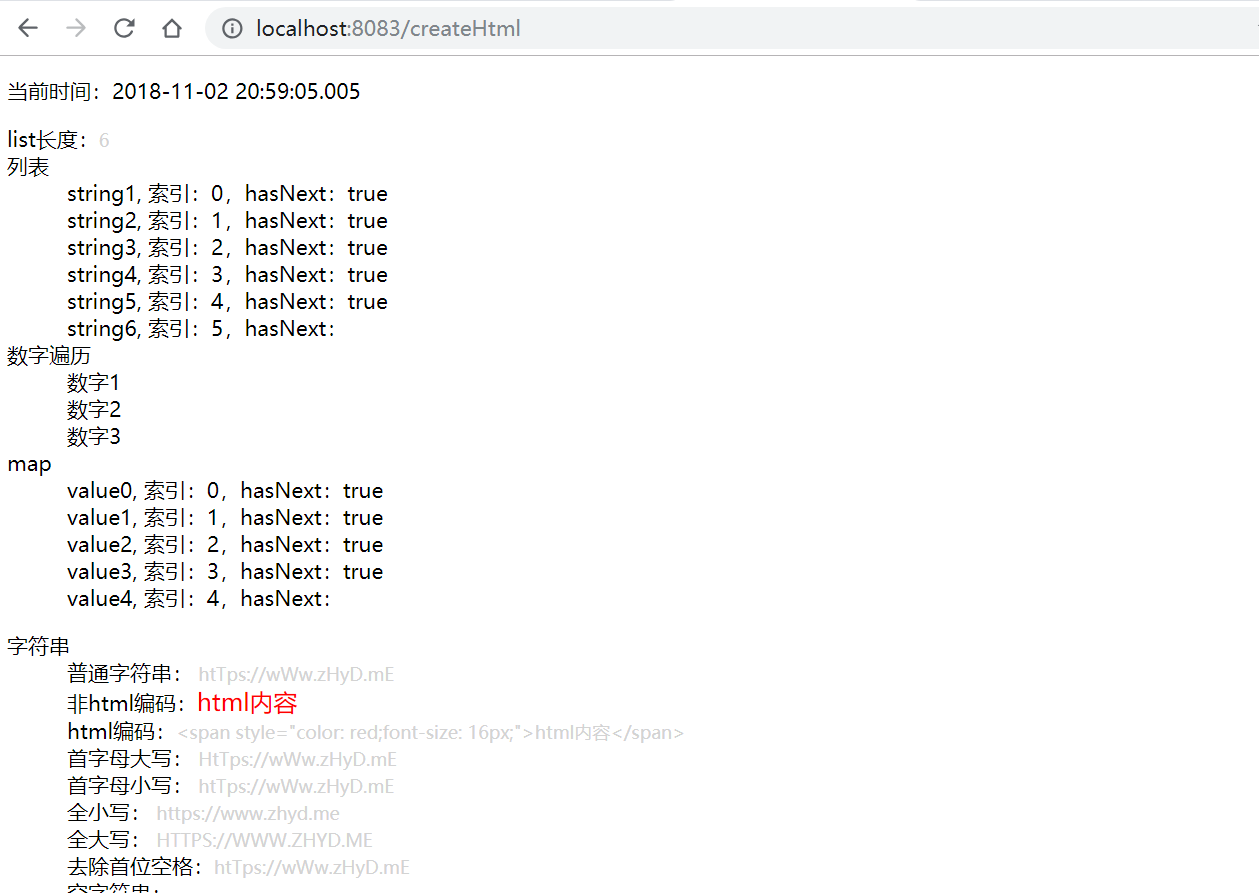springboot整合Freemark模板(修订-详尽版)
标签:
SpringBoot
本篇是SpringBoot项目实战(3):整合Freemark模板一文的修订版,本文使用示例详细介绍、演示了freemarker常用的语法,以及如何通过freemarker生成纯静态的html。
本文知识点:
想了解freemarker?没有比这篇文章更详细的了
springboot如何集成freemarker模板引擎
添加依赖
<dependency>
<groupId>org.springframework.boot</groupId>
<artifactId>spring-boot-starter-web</artifactId>
</dependency>
<dependency>
<groupId>org.springframework.boot</groupId>
<artifactId>spring-boot-starter-freemarker</artifactId>
</dependency>
配置属性文件
# 是否允许HttpServletRequest属性覆盖(隐藏)控制器生成的同名模型属性。
spring.freemarker.allow-request-override=false
# 是否允许HttpSession属性覆盖(隐藏)控制器生成的同名模型属性。
spring.freemarker.allow-session-override=false
# 是否启用模板缓存。
spring.freemarker.cache=false
# 模板编码。
spring.freemarker.charset=UTF-8
# 是否检查模板位置是否存在。
spring.freemarker.check-template-location=true
# Content-Type value.
spring.freemarker.content-type=text/html
# 是否启用freemarker
spring.freemarker.enabled=true
# 设定所有request的属性在merge到模板的时候,是否要都添加到model中.
spring.freemarker.expose-request-attributes=false
# 是否在merge模板的时候,将HttpSession属性都添加到model中
spring.freemarker.expose-session-attributes=false
# 设定是否以springMacroRequestContext的形式暴露RequestContext给Spring’s macro library使用
spring.freemarker.expose-spring-macro-helpers=true
# 是否优先从文件系统加载template,以支持热加载,默认为true
spring.freemarker.prefer-file-system-access=true
# 设定模板的后缀.
spring.freemarker.suffix=.ftl
# 设定模板的加载路径,多个以逗号分隔,默认:
spring.freemarker.template-loader-path=classpath:/templates/
# 设定FreeMarker keys.
spring.freemarker.settings.template_update_delay=0
spring.freemarker.settings.default_encoding=UTF-8
spring.freemarker.settings.classic_compatible=true
编写Controller
@Controller
public class FreemarkController {
@RequestMapping("/")
public String index(Model model) {
return "index";
}
}
页面
<!DOCTYPE html>
<html lang="en">
<head>
<title>SpringBoot + Freemarker</title>
<meta http-equiv="Content-Type" content="text/html; charset=UTF-8" />
</head>
<body>
<h1>Hello boy,</h1><br>
<p>当前时间:${.now?string("yyyy-MM-dd HH:mm:ss.sss")}</p>
</body>
</html>
常用的freemarker语法
下面详细介绍在ftl模板中如何使用列表、map、字符串、数字、日期、switch以及macro宏指令等语法。
修改下controller,传递一些需要处理的参数
@RequestMapping("/")
public String index(Model model) {
Map map = new LinkedHashMap<>();
for (int i = 0; i < 5; i++) {
map.put("key" + i, "value" + i);
}
model.addAttribute("list", Arrays.asList("string1", "string2", "string3", "string4", "string5", "string6"));
model.addAttribute("map", map);
model.addAttribute("name", " htTps://wWw.zHyD.mE ");
model.addAttribute("htmlText", "<span style=\"color: red;font-size: 16px;\">html内容</span>");
model.addAttribute("num", 123.012);
model.addAttribute("null", null);
model.addAttribute("dateObj", new Date());
model.addAttribute("bol", true);
return "index";
}
重写index.ftl
<!DOCTYPE html>
<html lang="en">
<head>
<title>Freemarker 语法大全</title>
<meta http-equiv="Content-Type" content="text/html; charset=UTF-8"/>
<style>
html {
font-size: 14px;
font-weight: 400;
}
.exp {
font-size: 12px;
color: lightgray;
}
</style>
</head>
<body>
<p>当前时间:${.now?string("yyyy-MM-dd HH:mm:ss.sss")}</p>
<dl>
<dt>list长度:<span class="exp">${list?size}</span></dt>
<dt>列表</dt>
<#list list as item>
<dd>${item }, 索引:${item_index },hasNext:${item_has_next}</dd>
</#list>
<dt>数字遍历</dt>
<#list 1..3 as item>
<dd>数字${item}</dd>
</#list>
<dt>map</dt>
<#list map?keys as key>
<dd>${map[key]}, 索引:${key_index },hasNext:${key_has_next}</dd>
</#list>
</dl>
<dl>
<dt>字符串</dt>
<dd>普通字符串:<span class="exp">${name}</span></dd>
<dd>非html编码:<span class="exp">${htmlText}</span></dd>
<dd>html编码:<span class="exp">${htmlText?html}</span></dd>
<dd>首字母大写:<span class="exp">${name?cap_first}</span></dd>
<dd>首字母小写:<span class="exp">${name?uncap_first}</span></dd>
<dd>全小写:<span class="exp">${name?lower_case}</span></dd>
<dd>全大写:<span class="exp">${name?upper_case}</span></dd>
<dd>去除首位空格:<span class="exp">${name?trim}</span></dd>
<dd>空字符串:<span class="exp">${null?if_exists}</span></dd>
<dd>是否包含某个字符串:<span class="exp">${name?contains("wWw")?string}</span></dd>
<dd>默认值:<span class="exp">${null?default("空值默认")}</span></dd>
<dd>“${name}”字符串长度:<span class="exp">${name?length}</span></dd>
<dd>定义字符串:<span class="exp">str=码一码<#assign str="码一码"/></span></dd>
<dd>字符串拼接(1):<span class="exp">${"字符串拼接 + " + str}</span></dd>
<dd>字符串拼接(2):<span class="exp">${"字符串拼接 + ${str}"}</span></dd>
<dd>字符串截取单个字符(1):<span class="exp">${str[1]}</span></dd>
<dd>字符串截取(2):<span class="exp">${str?substring(1)}</span></dd>
<dd>字符串截取(3):<span class="exp">${str?substring(1,2)}</span></dd>
<dd>indexOf:<span class="exp">${str?index_of("一")}</span></dd>
<dd>split分割字符串:<span class="exp">
<#list "a|b|c"?split("|") as item>
${item}
</#list>
</span></dd>
<dd>if...elseif...else:<span class="exp">
<#if null == ''>
匹配if显示
<#elseif null == '1'>
匹配elseif显示
<#else>
匹配else显示
</#if></span>
</dd>
</dl>
<dl>
<dt>switch</dt>
<dd>
<#switch str>
<#case "你好">
匹配“你好”
<#break >
<#case "码一码">
匹配“码一码”
<#break >
<#default>
默认匹配
</#switch>
</dd>
</dl>
<dl>
<dt>数字</dt>
<dd>普通数字:<span class="exp">${num}</span></dd>
<dd>数字类型:<span class="exp">${num?string.number}</span></dd>
<dd>货币类型:<span class="exp">${num?string.currency}</span></dd>
<dd>百分比类型:<span class="exp">${num?string.percent}</span></dd>
<dd>格式化数字:<span class="exp">${num?string("#.###")}</span></dd>
<dd>取数字的整数部分:<span class="exp">${num?int}</span></dd>
</dl>
<dl>
<dt>运算符</dt>
<dd>不等于:!= <span class="exp">例如:${(1 != 2)?string('1 != 2', '1 == 2')}</span></dd>
<dd>等于:== <span class="exp">例如:${(1 == 1)?string('1 == 1', '1 != 1')}</span></dd>
<dd>大于(1):> <span
class="exp">例如:${(2 > 1)?string('2 > 1', '2 < 1')}。<strong>注:使用> 时必须加括号,否则可能会被当成普通的标签闭合符号而引起报错</strong></span>
</dd>
<dd>大于(2):gt <span class="exp">例如:${(2 gt 1)?string('2 gt 1', '2 lte 1')}</span></dd>
<dd>大于等于:gte <span class="exp">例如:${(2 gte 2)?string('2 gte 2', '2 lt 2')}</span></dd>
<dd>小于(1):< <span
class="exp">例如:${(1 < 2)?string('1 < 2', '1 > 2')}。<strong>注:使用< 时必须加括号,否则可能会被当成普通的标签闭合符号而引起报错</strong></span>
</dd>
<dd>小于(2):lt <span class="exp">例如:${(1 lt 2)?string('1 lt 2', '1 gte 2')}</span></dd>
<dd>小于等于:lte <span class="exp">例如:${(2 lte 2)?string('2 lte 2', '2 gt 2')}</span></dd>
</dl>
<dl>
<dt>boolean</dt>
<dd>普通boolean输出:<span class="exp">${bol}</span></dd>
<dd>boolean判断输出:<span class="exp">${bol?string('true的时候显示','false的时候显示')}</span></dd>
</dl>
<dl>
<dt>日期</dt>
<dd>${dateObj?date}</dd>
<dd>${dateObj?time}</dd>
<dd>${dateObj?string("yyyy-MM-dd HH:mm:ss.SSS")}</dd>
</dl>
<dl>
<dt>import</dt>
<dd>
<#import "import.ftl" as importObj>
<p>${importObj.importStr}</p>
<p>${importObj.importStr1}</p>
</dd>
</dl>
<dl>
<dt>macro宏模板</dt>
<dd>
<#macro listMacro title items>
<p>${title?cap_first}:
<ul>
<#list items as item>
<li>${item?cap_first}</li>
</#list>
</ul>
<#nested >
</#macro>
</dd>
<dd>
<@listMacro items=["item1", "item2", "item3"] title="Items">
nested标签表示可以插入自定义的内容
</@listMacro>
</dd>
</dl>
👇👇👇👇👇👇👇👇👇👇👇👇👇👇👇👇👇👇👇👇 include 👇👇👇👇👇👇👇👇👇👇👇👇👇👇👇👇👇👇👇👇
<#include "eclipse.ftl">
</body>
</html>
通过freemarker生成静态html
首先需要编写一个可以在普通类中获取到springbean的工具类SpringContextHolder
@Component
public class SpringContextHolder implements ApplicationContextAware {
private static ApplicationContext appContext = null;
/**
* 通过name获取 Bean.
*
* @param name
* @return
*/
public static Object getBean(String name) {
return appContext.getBean(name);
}
/**
* 通过class获取Bean.
*
* @param clazz
* @param <T>
* @return
*/
public static <T> T getBean(Class<T> clazz) {
return appContext.getBean(clazz);
}
/**
* 通过name,以及Clazz返回指定的Bean
*
* @param name
* @param clazz
* @param <T>
* @return
*/
public static <T> T getBean(String name, Class<T> clazz) {
return appContext.getBean(name, clazz);
}
@Override
public void setApplicationContext(ApplicationContext applicationContext) throws BeansException {
if (appContext == null) {
appContext = applicationContext;
}
}
}
然后编写一个生成静态html文件的工具类FreemarkerUtil
public class FreemarkerUtil {
public static String parseTpl(String viewName, Map<String, Object> params) {
Configuration cfg = SpringContextHolder.getBean(Configuration.class);
String html = null;
Template t = null;
try {
t = cfg.getTemplate(viewName + ".ftl");
html = FreeMarkerTemplateUtils.processTemplateIntoString(t, params);
} catch (IOException | TemplateException e) {
e.printStackTrace();
}
return html;
}
}
为了方便查看, 添加一个mapping
@RequestMapping("/createHtml")
@ResponseBody
public String createHtml(Model model){
Map map = new LinkedHashMap<>();
for (int i = 0; i < 5; i++) {
map.put("key" + i, "value" + i);
}
model.addAttribute("list", Arrays.asList("string1", "string2", "string3", "string4", "string5", "string6"));
model.addAttribute("map", map);
model.addAttribute("name", " htTps://wWw.zHyD.mE ");
model.addAttribute("htmlText", "<span style=\"color: red;font-size: 16px;\">html内容</span>");
model.addAttribute("num", 123.012);
model.addAttribute("null", null);
model.addAttribute("dateObj", new Date());
model.addAttribute("bol", true);
return FreemarkerUtil.parseTpl("index", model.asMap());
}
ok,访问/createHtml
到此为止,本篇已详细介绍了freemarker的使用方法。
还是那句话
我可以对一个人无限的好,前提是值得。 ——慕冬雪
点击查看更多内容
7人点赞
评论
共同学习,写下你的评论
评论加载中...
作者其他优质文章
正在加载中
感谢您的支持,我会继续努力的~
扫码打赏,你说多少就多少
赞赏金额会直接到老师账户
支付方式
打开微信扫一扫,即可进行扫码打赏哦







